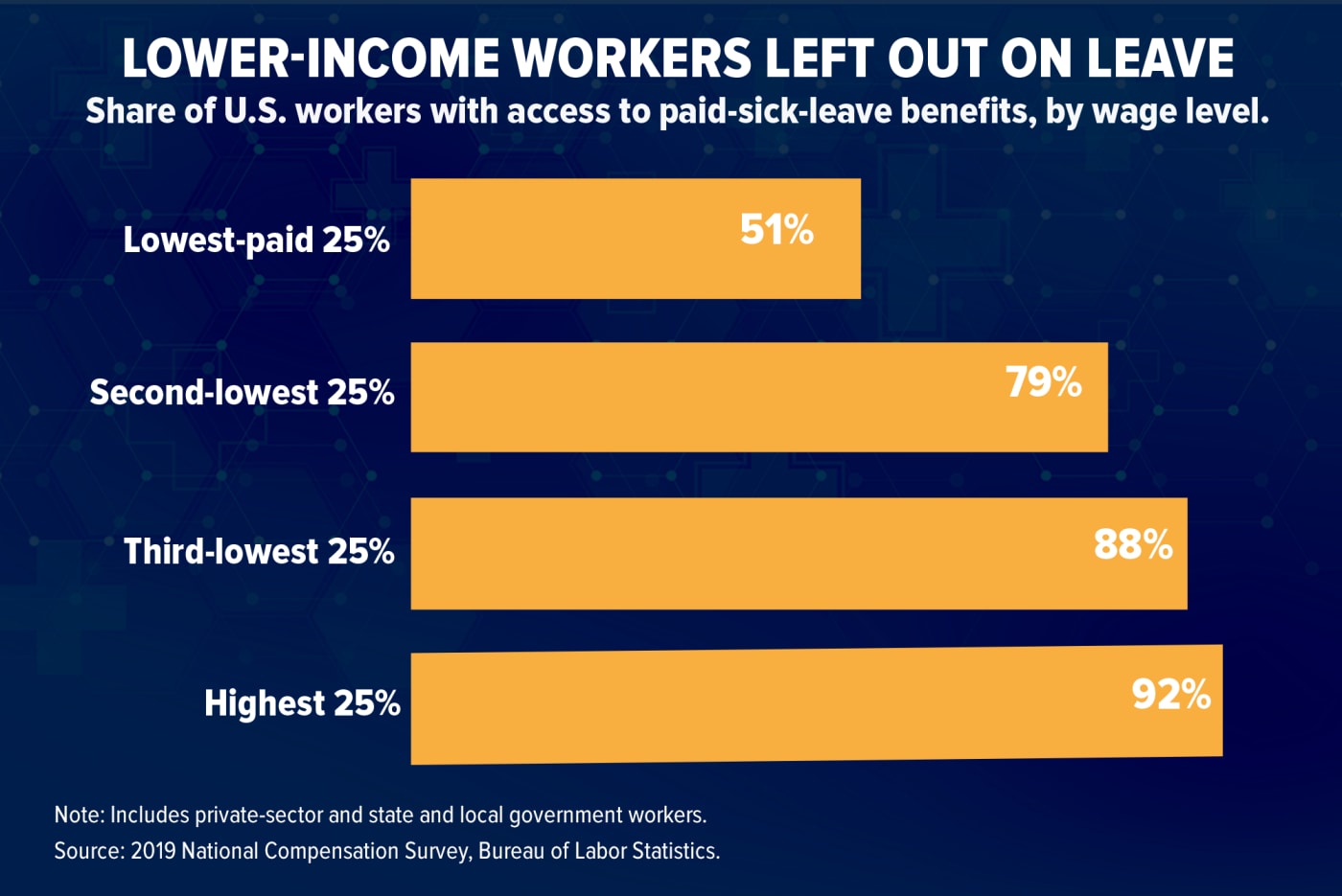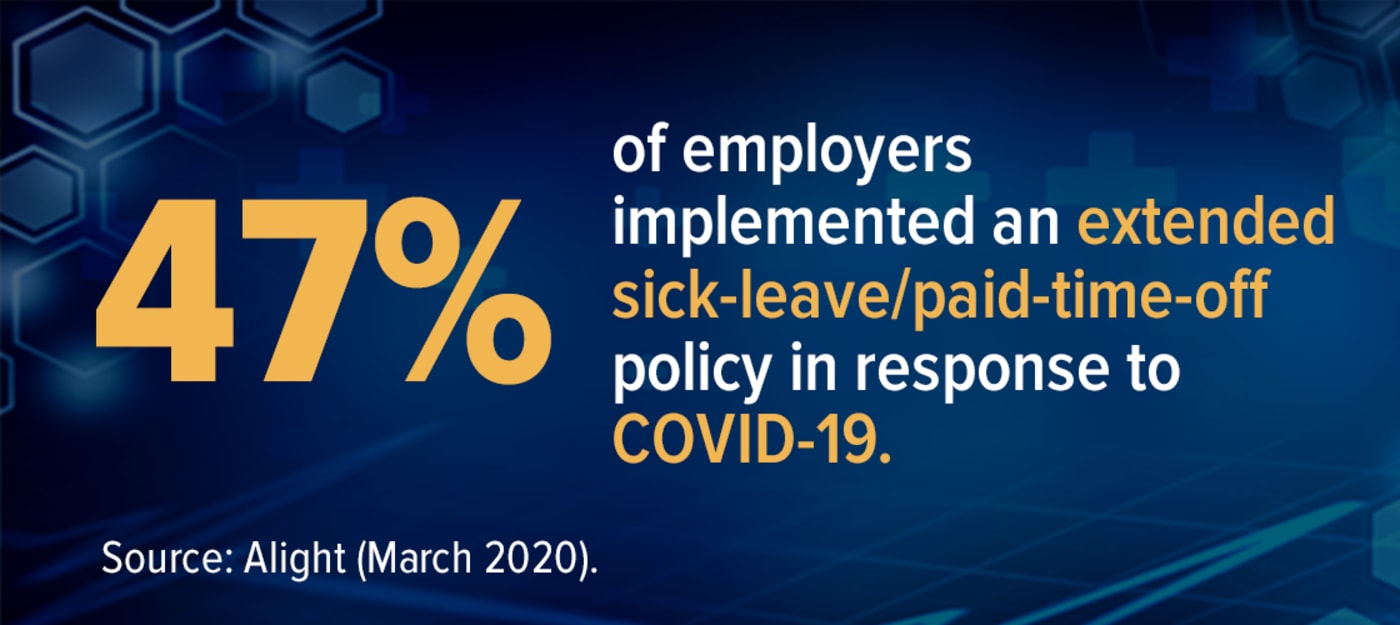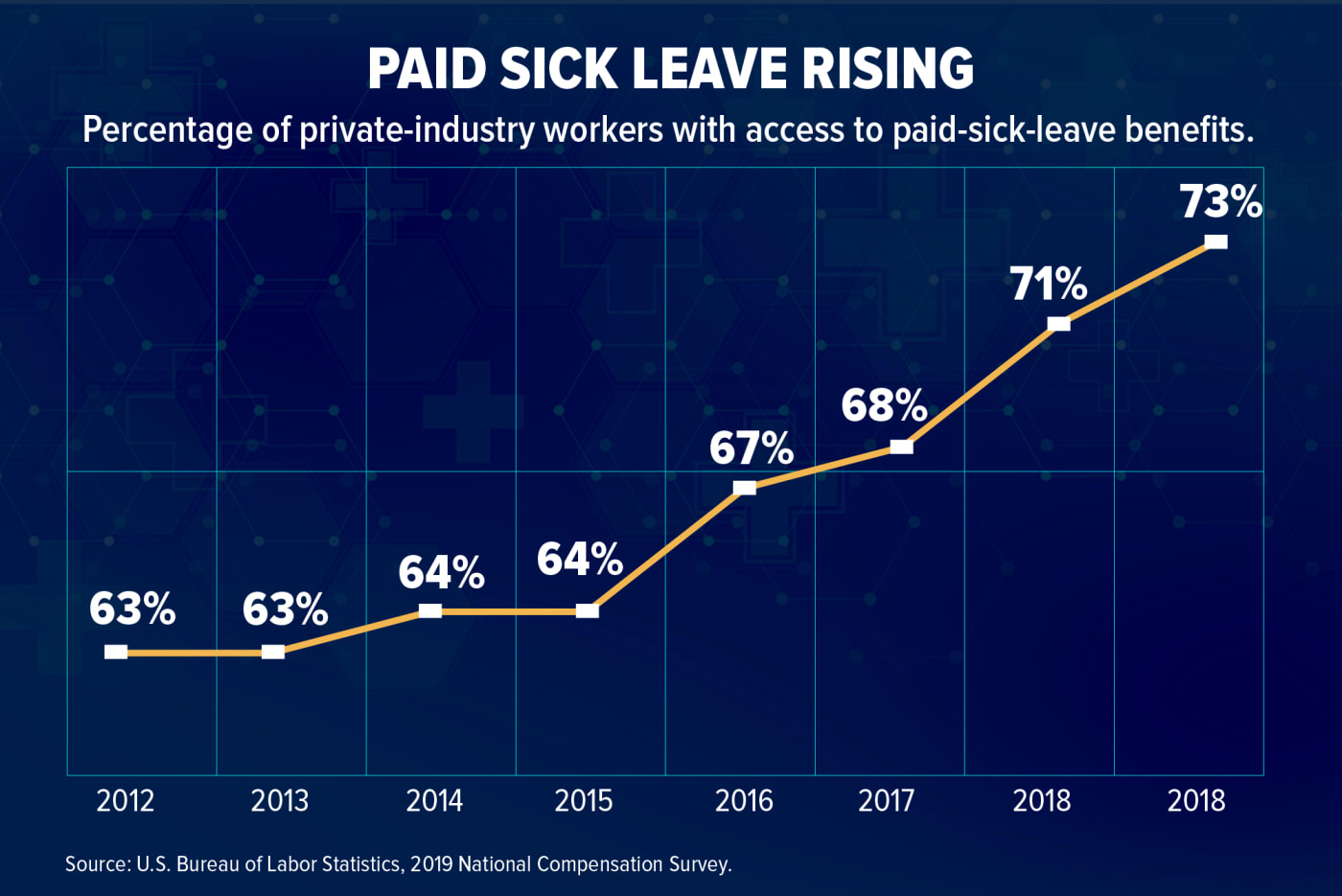COVID-19 Spurs Expanded Paid Leave
Many U.S. companies are recognizing the need to provide paid leave to more workers.
While the expansion of paid leave has been widely viewed in the C-suite as a robust talent-recruiting tool, it's also increasingly seen as the right thing to do amid the coronavirus pandemic.
"Since the outbreak of COVID, we've made some significant changes to our paid-leave policies," says Lauren McAdams, human resources director at Resume Companion, a career advancement services firm in Wilmington, Del. "Most notably, we've upped our paid-sick-day policy from five days to 15 days, and we're offering half pay for up to 40 days."
The company wants to ensure that employees who feel ill won't come to the office and potentially make others sick. Additionally, the firm is no longer requiring employees to give a reason for taking time off, McAdams says. "The new policy has encouraged employees to take time off for mental health reasons, to help their families or get important tasks done."
So far, the changes have been embraced by staffers. "We have noticed that the extra paid time off has boosted morale," she says.
A New Push for Paid Leave
As the nation came to grips with COVID-19 and its effects on the workplace, companies large and small re-examined and revamped their leave policies amid significant labor market turmoil: 29 percent of employers laid off workers at their U.S. locations, and 50 percent placed workers on a leave of absence, according to a report from Alight Solutions, a business process outsourcing company in Lincolnshire, Ill. Another 57 percent of companies took other actions, such as offering voluntary unpaid leaves of absence, and reducing hours and pay.
But companies also began offering additional aid in the form of sick leave and paid time off. Alight reported that 47 percent of the 246 employers surveyed "implemented or have started to implement an extended sick-leave/PTO [paid-time-off] policy." Another 11 percent were considering such an expansion.

Additionally, four out of five employers with an extended sick-leave/PTO policy made the policy applicable to all employees, though some employers specified that additional sick leave or PTO could only be used for circumstances related to the COVID-19 pandemic.
In March, Walmart instituted an emergency paid -sick-leave policy for associates. The benefit included pay replacement of up to 26 weeks for both full-time and part-time workers who contract the virus.
Other companies are scrambling to provide paid-leave policies that meet the unique needs of employers and staffers not only in the short-term but over the long haul.
"Since we are a global company with operations all over the world, we began taking action on COVID-19 early on," says Danielle Korins, chief people officer at Sterling, a provider of background services in New York City. "We enhanced our leave practices to accommodate people who were sick [whether COVID-related or not], needed to care for someone who was sick or simply had to quarantine for 14 days."
Korins says the company didn't want financial pressure to cause an employee who may have been exposed to the coronavirus to come to work and cause a greater problem. "We've kept those leave terms in place to deal with this pandemic and ensure that our employees are supported financially," she says.
In structuring its paid leave program, Korins says that it was critical to prioritize employee safety and trust. "It seems that right now, most companies are thinking of the safety of their employees, customers, partners and the communities in which they operate." Putting employees "in a position to choose between missing a paycheck because they are sick and risking their health and the health and safety of their colleagues just shouldn't be an option."
Government Advances Broader Leave
While paid leave has been a standard employee benefit option for years, government agencies have elevated the issue, especially during the coronavirus pandemic.
"States, municipalities and other jurisdictions increasingly require employers within their jurisdiction to provide paid sick leave and paid family leave," says Christopher Goldsmith, vice president at Segal Consulting in Tempe, Ariz.
In response to the pandemic, the federal government also mandated emergency sick leave and emergency family leave for certain workers.
Under the Families First Coronavirus Response Act (FFCRA), employers with fewer than 500 full-time or part-time employees can take advantage of new refundable payroll tax credits designed to reimburse them for the cost of providing leave to employees affected by COVID-19.
Under the act, effective through the end of 2020, the federal government will reimburse small and midsize businesses and nonprofit organizations for costs related to providing leave. Employees are eligible for up to 80 hours of paid sick leave, either to tend to their own health needs or to care for family members. The act also provides emergency paid family leave for parents who can't work because their children's schools or child care services are closed due to the pandemic.
The federal government has not publicly stated any plans to expand paid leave to larger employers during or after the COVID-19 crisis. But after the public health emergency subsides, employers operating in multiple states and jurisdictions may push for uniform federally mandated requirements instead of varying state and local laws, Goldsmith says.
Paid Leave for Gig Workers
In some cases, paid leave is becoming a company benefit for temp and "gig workers"—individuals who aren't considered full-time salaried or hourly hires but who work for companies on a contract basis. According to Gallup, 36 percent of U.S. workers are involved in the gig economy and the gig economy is growing three times faster than the traditional workforce.

In the age of COVID-19, gig workers have been especially valuable to the economy. Grocery and delivery workers at companies such as Instacart and GrubHub have become essential to many homebound Americans.
These contract workers often lack health insurance or sick leave, which puts them and the businesses they work for at risk if they fall ill.
That's why staffing firm Aquent started offering expansive paid-sick-leave benefits to its network of workers across the U.S. and Canada.
"By extending sick pay to all of our talent across the United States and Canada, we want to go above and beyond what is mandated by state laws," says Aquent CEO John H. Chuang. "Offering benefits is how companies attract and retain the best talent. Plus, it's also the right thing to do, especially during the COVID-19 pandemic, which has adversely affected the lives of so many workers."
Chuang noted there are about 20 million gig workers in the U.S. right now, adding the "time is right" to help gig workers out with the same sick-leave benefits that many traditional employees may take for granted.
"Gig workers don't get sick days," he says. Yet, nonsalaried contractors may make up 50 percent or more of the workforces at some large companies. There's a health risk in that scenario, as sick gig workers might show up on the job rather than lose a day's pay, thereby endangering other workers.

"While the government has taken some positive steps to help bring relief to businesses and workers, the sick-pay provisions of the Families First Coronavirus Response Act leaves millions of workers without coverage," Chuang says. "Sick pay should cover everyone, especially during a pandemic."
Aquent seeks to close that gap with a paid-sick-leave policy modeled after a ground-breaking Massachusetts law, which gives most workers "the right to earn and use up to 40 hours of job-protected sick time per year to take care of themselves and certain family members."
According to Aquent, the law mandates that "workers must earn at least one hour of sick leave for every 30 hours worked." For many of its workers, Aquent will retroactively accrue sick time earned from Jan. 1, 2020. For its workers in states and jurisdictions that already have sick-pay requirements in place, the existing laws will prevail.
"Benefits inequality is a major injustice in our country that needs to be addressed," Chuang says. "After all, the coronavirus does not discriminate between gig worker and a CEO."
Some companies that rely on gig workers are exploring the idea of an employer-sponsored fund to which contract workers could contribute to pay for their own paid leave.
Truxx, an Ithaca, N.Y.-based truck-sharing service that relies primarily on gig workers, advocates that approach., "We believe that paid-leave legislation is inevitable in the wake of the COVID-19 pandemic," says Jamie Hess, the company's CEO. "We encourage such legislation, and we believe it should include gig workers, too. The challenge is always going to be who funds the paid leave."
Hess recommends a paid-leave policy called gig worker paid-leave funds (GWPLF). "The idea would be to allow gig workers to make regular contributions to funds that would grow tax-free," he says. "During times of eligible illness or other qualifying events, they can withdraw funds to help them deal with issues related to health and well-being, such as sick leave, maternity/paternity and mental health needs, among other issues."
The accounts would work similarly to health savings accounts, Hess says, "giving gig workers a big leg up with paid-leave policies on the job."
Existing Models
Companies exploring new paid-leave policies have multiple plan options available. Goldsmith says these benefits in the U.S. generally fall into one of three types:
Accrual arrangements. Employees earn sick leave as they work and can use accumulated sick leave for designated purposes. At the end of the year, unused sick leave carries over to the next year, up to a maximum amount.
Deposit arrangements. The employer allocates to workers a set amount of sick leave days per year. Leave is usually "use it or lose it"—there is no carryover of unused leave.
PTO. Sick leave is combined with vacation time, and there is no distinction between the two.
Sick leave can include many features or policy provisions. "We see a great deal of variety with what companies consider the permitted use of sick leave," Goldsmith says. All sick leave arrangements cover employees' personal sicknesses. Some include or exclude:
- Personal medical appointments.
- Medical appointments for family members.
- Leave for bonding with new babies.
- Leave to care for family members with an illness.
- Bereavement leave.
Of course, an employer cannot anticipate if and when a public health emergency such as the COVID-19 pandemic might occur. But a comprehensive paid-leave policy will help an organization protect all its employees and its reputation as well.
Brian O'Connell is a Bucks County, Pa.-based freelance business writer.
Explore Further
SHRM provides advice and resources to help businesses establish an effective employee leave program.
SHRM Resource Center: Paid Time Off
Paid-leave benefits can help employees balance work and life and come back to the job revitalized. Use this resource center to discover ways to offer this popular benefit to employees.
HR Q&A: How Does the Families First Coronavirus Response Act Impact Employers?The Emergency Family and Medical Leave Expansion Act amends the current Family and Medical Leave Act (FMLA), allowing leave for eligible employees.
SHRM Toolkit: Managing Through Flu and Other Epidemics in the Workplace
Employers should anticipate that they will periodically face epidemics and other biological threats and take proactive steps to protect their employees and their organizations. This article provides a roadmap for managing an epidemic in the workplace.
SHRM Resource Center: Coronavirus and COVID-19
Communicable diseases like coronavirus and the respiratory illness it causes, COVID-19, can bring a busy workforce to a standstill. This resource center provides the latest news and updates to help you work your way through the pandemic.



